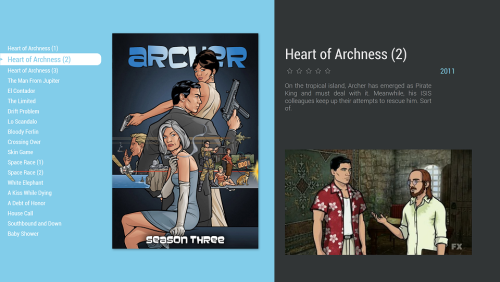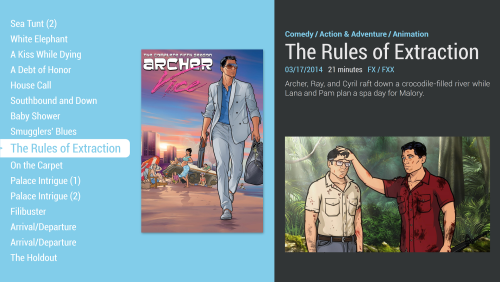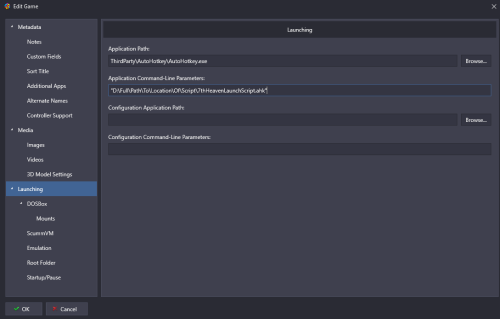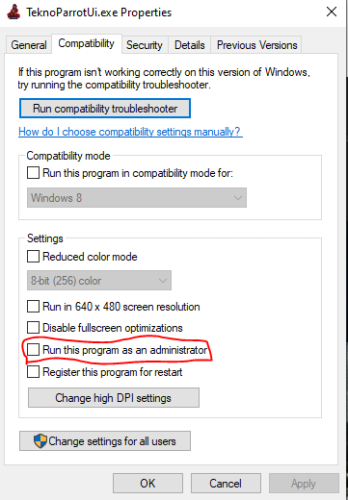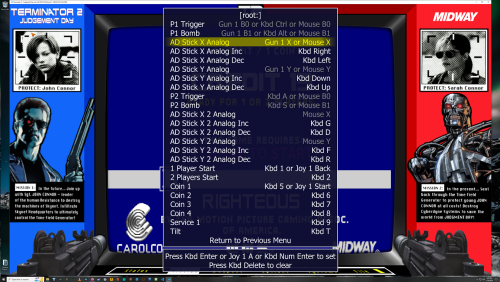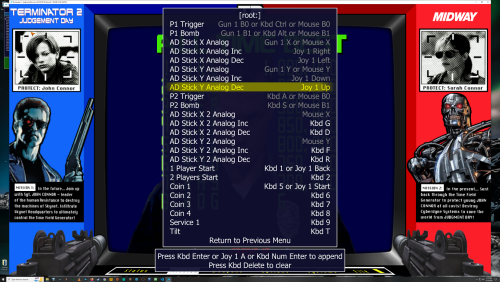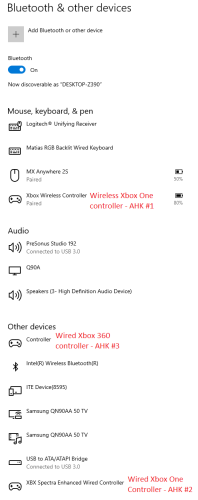
skizzosjt
Members-
Posts
731 -
Joined
-
Last visited
-
Days Won
1
Content Type
Profiles
Forums
Articles
Downloads
Gallery
Blogs
Everything posted by skizzosjt
-
I noticed this has always been this emulators behavior for me regardless of whatever version I'm on, normal release or early access release. So, I see the same behavior as @oldgamer. Regarding @Mainiack's setup. "Attempt to hide console window at startup/shutdown" doesn't make sense to use because that's for emulators that create a command line window and Yuzu doesn't do that. That setting is useful for an emulator like MAME which does create a command line (console) window. Regardless, checking or unchecking that doesn't impact this behavior. The only thing I see different from mine besides that is checking "Aggressive Startup Window Hiding" and that does not make any change to this behavior for me. I do have a solution for this I've used before. You could use a script to bring the Shutdown Screen to the front and make it "AlwaysOnTop" and THEN exit the emulator. This way when it does go into a window for a split sec you don't see this happen. It will be instead hidden by the Shutdown Screen. So, with that said, I'm assuming you also use Startup and Shutdown screens or this plan falls apart. I did this trick for some other emulators in the past, but point being you can apply this same script to any other emulator that does this windowing at exit thing too. Running Script Esc:: WinSet, AlwaysOnTop, , LaunchBox Game Startup Sleep, 500 WinClose, ahk_exe {{{StartupEXE}}} Exit Script (for Pause Screen exiting) WinSet, AlwaysOnTop, , LaunchBox Game Startup Sleep, 500 WinClose, ahk_exe {{{StartupEXE}}} Take note you will still have the emulator go into a window if you exit via some other hotkey or controller binding. So if you normally use Big Box's "close active window" controller binding for example, you would still see the emulator go to window when using that. You would have to make a script with a hotkey that is triggered by whatever controller button(s) being pushed in order for that exiting method to work hiding the windowing emulator. Alternatively, you could make a controller button send escape via a remapper and that would trigger the script in the Running Script field. Here is an example of using the Guide button, double pressing it to activate the same running script, so this just makes the running script a little longer Esc:: CloseGame: WinSet, AlwaysOnTop, , LaunchBox Game Startup Sleep, 500 WinClose, ahk_exe {{{StartupEXE}}} Return vk07:: ;Xbox guide button If (A_ThisHotkey = A_PriorHotkey && A_TimeSincePriorHotkey < 300) Goto, CloseGame
-
Guide button chords will work 24/7 as long as Steam is running....take note, running, it does not need to be in focus for the various Guide button chords to work I think you're calling the Game Overlay the Steam Guide button overlay, default keys are SHIFT+TAB or the Guide button on controller. This only opens when a Steam game, or non-Steam game in your library is actually running. So if you want that to appear while using Big Box then you would need to add Big Box as a non-Steam game to your Steam library. This does not break SteamLauncher, or at least, I don't know why you think so? Steam to my surprise lets you run multiple games simultaneously, at least from the same system, I have not tried this across multiple systems signed into the same Steam account for instance. But my point being if you had Big Box running as a non-Steam game and then launched for ex some NES game using SteamLauncher, it by theory, should work as normal. I test this theory just now, and does seem to work as I described. I can still launch a NES game with SteamLauncher while I have an official Steam game or Big Box already running through Steam. Image here for some proof If you wanted to access Big Picture Mode there should be shortcuts for that. I don't use it but also have opened it on accident many times. From what I can tell it's by default holding down the Guide button. It also seems Steam needs to be in focus for that to work though. But, there is also a setting to make Steam come to focus with a press of the Guide button, so between using both of those settings you should be able to bring up BPM with just the Guide button. Hey Lahma, I can tell from skimming through this thread you have put in lots of blood sweat and tears into this project. Things just keep getting changed that are out of your control and you gotta find the next solution each time, it sounds, frustrating to say the least. So it honestly pains to report something isn't working right for Startup/Shutdown screens. I've really only tested with Retroarch games, cores for mainly 8bit and 16bit systems like NES, SNES, Sega Genesis and Master System. What happens is it seems the SteamLauncherProxy window yanks focus away from the emulator after a few seconds pass by, forcing me to ALT+TAB back into the emulator. I changed some setting in the plugin to delay that ("Prevent Steam Focus Stealing") but it just sort of delays the inevitable. So that's really my main gripe, it requires this extra user intervention step to get back into the emulator/game being launched by SteamLauncher. This doesn't occur if I disable the Startup Screen. The issue with Shutdown Screen is mostly cosmetic, just a bunch of flashing back and forth between the frontend, emulator, and Shutdown Screen. So doesn't require user intervention, just looks pretty bad. The reason I'm digging this plugin is due to I recently got myself familiar with using Steam Input and it just makes any and every remapper I've ever used look like a kiddie toy lol. It's so powerful what it can do! Seems only your imagination is your limit with that tool. So I would love the ability to make better use of Steam Input and this plugin allows that to happen but I'm bummed about the Startup/Shutdown screens not working quite right. Should you find the time to look into this and better yet, resolve it, you will make some stranger like me quite the happy gamer! With that said, I thought I should do a couple other systems real quick that aren't using Retroarch. I tried Cemu and Yuzu and both of these emulators suffer some issues, mostly the same way too. Neither forced me to ALT+TAB into the emulator, so that's a plus. However, it still does a bunch of flashing between emulator, Startup Screen and frontend though. And it also did that flashing of windows routine at exit of the game/emulator. The Shutdown Screen seems pretty delayed when using SteamLauncher too for any of these emulators, Retroarch, Cemu or Yuzu. Couple secs go by before it initiates, it's normally instantly. This lends to flashing back to the frontend when it should instead go directly from the game/emulator to the Shutdown Screen. So by comparison, Cemu and Yuzu work one notch better not needing to ALT+TAB but the process of windows flashing back and forth at game launch and exit is ugly looking. I understand this can be considered nitpicking, as I must give credit where it's due. Functionality of the plugin does check all the boxes and work as it's supposed to for what I've tried so far. Besides Retroarch needing the extra ALT+TAB input, this is just all ugly cosmetic issues.
- 878 replies
-
- 1
-

-
it's working fine for me. I can search for entries and moderate submissions, etc. sooo yea
-
BigBox scroll wheel images have black bar over them..
skizzosjt replied to Smackenroll's topic in Troubleshooting
does this got anything to do with Intel iGPU settings? I don't recall specifics but seems like when people get funny looking images there was advice to set anti-aliasing (or some similar setting) option to either on or off because having it on auto would create the issue.....stab in the dark here from me. search found this post to clarify it for me. I couldn't remember that "nahimic" name either, but that def came to mind too when I saw this post. seems to always be connected to problems like this. issue isn't the same in this thread, but I recall it impacting others similarly search for "nahimic" finds this post - looks exactly like current users issue. so I'd follow this one's advice! update Intel iGPU drivers! or change from using iGPU to your dGPU if your system has one -
thank you for checking! maybe some magic Christmas PC tech elves paid us a visit over the holiday or what lol. there were some recent Windows 10 updates but even that is quite a stretch to think that would somehow be connected to this getting fixed back to normal. I'll take the win as is since it just landed in our laps like this
-
the scripts I posted still work fine for some unknown magical reason because I've changed literally NOTHING since my last posts regarding the frontend or CEMU, or really anything about my PC, but "close active window" controller binding works perfectly fine again for me. I'll admit that is bizarre. for what it's worth I map it as the first button to be the start button and the second button to be the B button. for the record checking/unchecking remembering window position has nothing to do with that error. I never use it and I was able to create the same error when I was troubleshooting this last month, but it was completely, 100%, random. Having it checked now does not make the error get thrown. When it did happen to me I found no rhyme or reason why it occurred but it only occurred for me when using the close active window controller binding/hotkey. but to be clear, it was totally random, it did not happen every time close active window via controller was used. It definitely did not occur when using the keyboard. this was the reason why I posted the script to close the emulator via double clicking the guide button. it was the first workaround that came to my mind at that point in time. my running script is still the same as I posted last time, and the exit script (ie exiting via the Pause Screen) is the same thing but written appropriately for the Pause Screen Exit Script field. still works fine for me. WinClose, ahk_exe {{{StartupEXE}}} Hey @Retro808, would you mind firing up CEMU and see if closing it via the controller close active window bind misbehavior changed for you too? This is weird.....it somehow fixed itself for me lol.....I mean....this is a good problem to be having 😄
-
TV Series Scraper View File Thank you for checking out TV Series Scraper! This tool will give LaunchBox and Big Box users the ability to easily add TV episodes to their library. This is an AHK script written in V1 syntax and uses TMDB (The Movie Database) as its source for metadata and images Users will be required to supply their own API key from https://www.themoviedb.org/ which is 100% free of charge and only takes the time needed to sign up creating a user name, and requesting an API key from within your user profile. Within the .7z file there is a .ahk version and a .exe version. Both will operate exactly the same! If you are not familiar with setting up AHK then please use the .exe version. #WHAT IT DOES# -It will edit your PLATFORM XML file accordingly to add all data into LaunchBox and download both SEASON and EPISODE specific images -SORT TITLE will be applied in the format of "TV SERIES SXXEXX EPISODE TITLE" to organize all series episodes together in proper sequential order -SEASON specific images are saved into the platform's BOX - FRONT directory -EPISODE specific images are saved into the platforms SCREENSHOT - GAMEPLAY directory -METADATA applied will be the following: Series title (within sort title) Series genre(s) Series network(s) Sort Title (in the format of SERIES TITLE SXXEXX EPISODE TITLE) Season number (within sort title) Episode number (within sort title) Episode title Episode overview Episode air date Episode Run Time (*only if custom field was added - see notes below) #HOW TO USE# -Import your video files into your platform -Without editing these entries, close LaunchBox -Open LaunchBox again, and now BULK EDIT the entries as follows Edit the SERIES field with the TV SERIES NAME Edit the RELEASE DATE field with ANY DATE Optional but recommended Add a CUSTOM FIELD by doing the following Edit a SINGLE ENTRY Go to CUSTOM FIELDS tab Add a custom field name called "Run Time" Enter any value into the value field, for ex: "20" Custom fields only save if a value is assigned to at least a single entry Now BULK EDIT all entries again to edit the custom field "Run Time". Enter any value into the field -Close LaunchBox -Open TV Series Scraper -If this is your first launch, you must go to API KEYS tab and enter in your TMDB API KEY! -On the TMBD tab, enter the TV SERIES into TV SERIES field -Select the specific platform XML file using the BROWSE button -Then click the SEARCH button You will be prompted if the search result is correct or if you want to see the next result -Once you select a result all matching entries in your LaunchBox library will be populated into the EPISODES LIST drop down This is to review if all of your episodes are in proper sequential order -Also once a search result is selected, if the TV series has additional "episode groups" then you will be able to change EPISODE GROUP TYPE to "Alternative" and then select the EPISODE GROUP NAME of your choice -Once you are ready with your settings, click SCRAPE to begin the process! #SETTINGS & FEATURES# TMDB Tab SKIP SPECIALS checkbox will do just that. If a TV series has specials, as in, episodes that do not correlate to any particular season, these can be skipped over if the checkbox is enabled EPISODE LIST is to review if your episodes are all in proper sequential order. If they are, you are free to pick either image naming format. ENTRY TITLE, or FILE NAME. If your episodes are NOT in proper sequential order, then you should ONLY use ENTRY TITLE. If FILE NAME is used and your episodes are not in sequential order, then images will not be assigned to the proper entry! Batch File Rename Tab (see below for details) API Keys Tab Go to this tab to enter in your TMDB API key. The script will NOT function without this key! Settings Tab Search settings All of these settings will use different logic on how to match to your entries file name. Choose the one(s) that best fit your files naming scheme Each checkbox will display a tool tip to give an example of what it is using Use first search result will bypass the message prompt so the user can confirm they have the right series. Exact match only checkbox is the strictest search method and requires finding the SERIES TITLE, the SEASON AND EPISODE NUMBER, and the EPISODE NAME in your entries file name. This search method is ALWAYS enabled as the default but when this checkbox is enabled, all additional fallback search options are DISABLED Image settings ENTRY TITLE will name all images as the entries title (episode title) FILE NAME will name all images as the entries file name. Do NOT use this setting if your episode list is not completely in proper sequential order since images will not end up being named correctly Download first image found is permanently enabled. Potential improvement for future revision is to give users ability to choose additional images should they exist Additional Notes If you choose to add multiple TV series to a single platform then it is recommended to NOT use the "Season # & episode #" search option (SXXEXX). This is due to it will only need to find for ex "S09E10" in a file name and will likely result in applying metadata and images for TV series "A" to a TV series "B" entry! This is the the "loosest" search setting as it has nothing specific to the TV series title, or to the individual episode title. Going off the above note, if all your TV series are separated into their own individual platforms, then using the "Season # & episode #" search option is very reliable assuming your file names have SXXEXX in them If you are having issues with getting good matches even with various search settings then you should utilize the Batch File Renamer to get your file's names better suited! SPECIALS, as in episodes that do not correlate to any specific season, will be considered part of "season 0" and given a sort title in LaunchBox as "SERIES TITLE S00EXX EPISODE TITLE" If you want to provide SEASON SPECIFIC images rather than have them downloaded from TMDB then place your image files into the "Images To Duplicate" folder prior to scraping. Images must be named in the following format: SERIES TITLE SXX For ex: Image file name "Archer S05.png" will be applied to every episode of Archer from its fifth season #BATCH FILE RENAMER# -This tool will batch rename files to the following format: SERIES TITLE SXXEXX EPISODE TITLE -Having files named like this will guarantee good matches with even the strictest default setting of Exact match only! -This tool will only rename files on a per season basis. For ex, if a TV series has 10 seasons and you want them all renamed, you will need to run this batch file rename 10 separate times -The files in the selected directory MUST be in PROPER SEQUENTIAL ORDER! However, they can be named LITERALLY ANYTHING! -What the batch file renamer does is take the first file found and gives it the name of the first episode for the series and season you entered. It then takes the second file found and gives it the second episodes name. Then it takes the third file found and gives it the third episodes name....and so on. -To use do the following: Enter the TV SERIES into the TV SERIES field Enter the SEASON NUMBER into the SEASON NUMBER field Enter your files FILE EXTENSION into the FILE EXTENSION field Select the directory which you want to batch rename files using the BROWSE button Click the SEARCH button You will be prompted if the correct search result came up. Once the proper search result is selected you can then select an ALTERNATIVE EPISODE GROUP should you want to use one, if the series has more than just the default episode group. With all fields filled in as desired, click the RENAME button. Your files will be renamed accordingly in just seconds! -CAUTION IS ADVISED! Back up your files first! There is no undo button associated with this action should you make a mistake #GETTING TMDB API KEY# -Once you have logged into your TMDB account you can click on your user name icon in the top right corner. In the pop-up menu click on "Edit Profile". -In the left hand list click on API which will be near the bottom of the list -Here you will be able to request and retrieve your own API key #THANK YOU# @Whatscheiser worked as a beta tester for v2.0 and their feedback was critical to making the tool better! Your time and efforts are much appreciated! #EXAMPLE IMAGES# Example for use in Big Box #EXAMPLE VIDEO# Showing the setup process to import and scrape for an entire season in just a few minutes! Please note video editing took place during the scrape progress so the video could be shortened TV Series Scraper Tutorial.mp4 #SUPPORT# Please keep all questions and requests for help in the main discussion and support thread. If you are reading this, you are currently in the main discussion and support thread! Submitter skizzosjt Submitted 01/17/2024 Category Third-party Apps and Plugins
-
Version 2.0
240 downloads
Thank you for checking out TV Series Scraper! This tool will give LaunchBox and Big Box users the ability to easily add TV episodes to their library. This is an AHK script written in V1 syntax and uses TMDB (The Movie Database) as its source for metadata and images Users will be required to supply their own API key from https://www.themoviedb.org/ which is 100% free of charge and only takes the time needed to sign up creating a user name, and requesting an API key from within your user profile. Within the .7z file there is a .ahk version and a .exe version. Both will operate exactly the same! If you are not familiar with setting up AHK then please use the .exe version. #WHAT IT DOES# -It will edit your PLATFORM XML file accordingly to add all data into LaunchBox and download both SEASON and EPISODE specific images -SORT TITLE will be applied in the format of "TV SERIES SXXEXX EPISODE TITLE" to organize all series episodes together in proper sequential order -SEASON specific images are saved into the platform's BOX - FRONT directory -EPISODE specific images are saved into the platforms SCREENSHOT - GAMEPLAY directory -METADATA applied will be the following: Series title (within sort title) Series genre(s) Series network(s) Sort Title (in the format of SERIES TITLE SXXEXX EPISODE TITLE) Season number (within sort title) Episode number (within sort title) Episode title Episode overview Episode air date Episode Run Time (*only if custom field was added - see notes below) #HOW TO USE# -Import your video files into your platform -Without editing these entries, close LaunchBox -Open LaunchBox again, and now BULK EDIT the entries as follows Edit the SERIES field with the TV SERIES NAME Edit the RELEASE DATE field with ANY DATE Optional but recommended Add a CUSTOM FIELD by doing the following Edit a SINGLE ENTRY Go to CUSTOM FIELDS tab Add a custom field name called "Run Time" Enter any value into the value field, for ex: "20" Custom fields only save if a value is assigned to at least a single entry Now BULK EDIT all entries again to edit the custom field "Run Time". Enter any value into the field -Close LaunchBox -Open TV Series Scraper -If this is your first launch, you must go to API KEYS tab and enter in your TMDB API KEY! -On the TMBD tab, enter the TV SERIES into TV SERIES field -Select the specific platform XML file using the BROWSE button -Then click the SEARCH button You will be prompted if the search result is correct or if you want to see the next result -Once you select a result all matching entries in your LaunchBox library will be populated into the EPISODES LIST drop down This is to review if all of your episodes are in proper sequential order -Also once a search result is selected, if the TV series has additional "episode groups" then you will be able to change EPISODE GROUP TYPE to "Alternative" and then select the EPISODE GROUP NAME of your choice -Once you are ready with your settings, click SCRAPE to begin the process! #SETTINGS & FEATURES# TMDB Tab SKIP SPECIALS checkbox will do just that. If a TV series has specials, as in, episodes that do not correlate to any particular season, these can be skipped over if the checkbox is enabled EPISODE LIST is to review if your episodes are all in proper sequential order. If they are, you are free to pick either image naming format. ENTRY TITLE, or FILE NAME. If your episodes are NOT in proper sequential order, then you should ONLY use ENTRY TITLE. If FILE NAME is used and your episodes are not in sequential order, then images will not be assigned to the proper entry! Batch File Rename Tab (see below for details) API Keys Tab Go to this tab to enter in your TMDB API key. The script will NOT function without this key! Settings Tab Search settings All of these settings will use different logic on how to match to your entries file name. Choose the one(s) that best fit your files naming scheme Each checkbox will display a tool tip to give an example of what it is using Use first search result will bypass the message prompt so the user can confirm they have the right series. Exact match only checkbox is the strictest search method and requires finding the SERIES TITLE, the SEASON AND EPISODE NUMBER, and the EPISODE NAME in your entries file name. This search method is ALWAYS enabled as the default but when this checkbox is enabled, all additional fallback search options are DISABLED Image settings ENTRY TITLE will name all images as the entries title (episode title) FILE NAME will name all images as the entries file name. Do NOT use this setting if your episode list is not completely in proper sequential order since images will not end up being named correctly Download first image found is permanently enabled. Potential improvement for future revision is to give users ability to choose additional images should they exist Additional Notes If you choose to add multiple TV series to a single platform then it is recommended to NOT use the "Season # & episode #" search option (SXXEXX). This is due to it will only need to find for ex "S09E10" in a file name and will likely result in applying metadata and images for TV series "A" to a TV series "B" entry! This is the the "loosest" search setting as it has nothing specific to the TV series title, or to the individual episode title. Going off the above note, if all your TV series are separated into their own individual platforms, then using the "Season # & episode #" search option is very reliable assuming your file names have SXXEXX in them If you are having issues with getting good matches even with various search settings then you should utilize the Batch File Renamer to get your file's names better suited! SPECIALS, as in episodes that do not correlate to any specific season, will be considered part of "season 0" and given a sort title in LaunchBox as "SERIES TITLE S00EXX EPISODE TITLE" If you want to provide SEASON SPECIFIC images rather than have them downloaded from TMDB then place your image files into the "Images To Duplicate" folder prior to scraping. Images must be named in the following format: SERIES TITLE SXX For ex: Image file name "Archer S05.png" will be applied to every episode of Archer from its fifth season #BATCH FILE RENAMER# -This tool will batch rename files to the following format: SERIES TITLE SXXEXX EPISODE TITLE -Having files named like this will guarantee good matches with even the strictest default setting of Exact match only! -This tool will only rename files on a per season basis. For ex, if a TV series has 10 seasons and you want them all renamed, you will need to run this batch file rename 10 separate times -The files in the selected directory MUST be in PROPER SEQUENTIAL ORDER! However, they can be named LITERALLY ANYTHING! -What the batch file renamer does is take the first file found and gives it the name of the first episode for the series and season you entered. It then takes the second file found and gives it the second episodes name. Then it takes the third file found and gives it the third episodes name....and so on. -To use do the following: Enter the TV SERIES into the TV SERIES field Enter the SEASON NUMBER into the SEASON NUMBER field Enter your files FILE EXTENSION into the FILE EXTENSION field Select the directory which you want to batch rename files using the BROWSE button Click the SEARCH button You will be prompted if the correct search result came up. Once the proper search result is selected you can then select an ALTERNATIVE EPISODE GROUP should you want to use one, if the series has more than just the default episode group. With all fields filled in as desired, click the RENAME button. Your files will be renamed accordingly in just seconds! -CAUTION IS ADVISED! Back up your files first! There is no undo button associated with this action should you make a mistake #GETTING TMDB API KEY# -Once you have logged into your TMDB account you can click on your user name icon in the top right corner. In the pop-up menu click on "Edit Profile". -In the left hand list click on API which will be near the bottom of the list -Here you will be able to request and retrieve your own API key #THANK YOU# @Whatscheiser worked as a beta tester for v2.0 and their feedback was critical to making the tool better! Your time and efforts are much appreciated! #EXAMPLE IMAGES# Example for use in Big Box #EXAMPLE VIDEO# Showing the setup process to import and scrape for an entire season in just a few minutes! Please note video editing took place during the scrape progress so the video could be shortened TV Series Scraper Tutorial.mp4 #SUPPORT# Please keep all questions and requests for help in the main discussion and support thread rather than this file download thread. If you need any support, please click the "GET SUPPORT" button at the top of this page! -
the startup/shutdown screens are triggered by the main launching app existing and then not existing. so if a mod launcher boots up first to boot this game with said mods, and then the launcher closes then the game over screen is going to get triggered prematurely at that point. you just need to rethink your approach on how to launch it because you misunderstand how the startup and shutdown screens work. So scripting will fix this issue. In the below script insert in the full path to the 7th Heaven Launcher, and also make sure to change "FFVII.exe" to whatever the game exe file actually is if it's something different. Paste this below script into a text file and save it as something like "7thHeavenLaunchScript.ahk" Run, "D:\Full\Path\to\Launcher\7th Heaven.exe" /LAUNCH /QUIT WinWait, ahk_exe FFVII.exe WinWaitClose, ahk_exe FFVII.exe The script does this: Runs the mod launcher as normal so everything from there goes as business as usual WinWait says "Wait for this window to exist" WinWaitClose says "Wait for this window to close" and then script terminates when that window closes. If the script is used as the main exe the Shutdown screen gets triggered at the appropriate point in time, at game exit, which is due to the script terminates at game exit. So in the game entry, you need the application path to point to the copy of AHK that is included with LB, which is in ThirdParty\AutoHotkey. In the command line parameters you need to insert the full path to the script and make sure to use quotes around it
-
Hi Neo, I just explained this on page 56 so please go read those two posts. Make sure you read this new post here in it's entirety too. Also the two "underneath" buttons are duplicates of whatever you program them to be via the controller's program button which is also on the underside. These buttons on the bottom of the controller only are detected by any program or game if you assigned them a button, so if you never programmed them, it makes sense why no program or game detects them. They have exact same controller I do and the key issue there is due to it being an Xbox One model. But I'd bet also lending to the issue as a whole is same thing you and I mention about Joy (controller) number. I played around with an example of how to use Xbox One or Xbox Series X controller specific hotkeys, or detecting any controller input from these models without use of xinput library. Since you need an active window for GetKeyState to capture those inputs correctly, I thought maybe I make a little menu to select a few things. This is just a proof of concept script, as it does nothing practical other than demonstrate this. Recently found triple click hotkey examples, so thought I'd show an example of that here too. This one you would need to triple click on the Guide button to bring up a window. Now that a window from the script is in focus, controller specific hotkeys and GetKeyState will work for even Xbox One and Series X controllers. These two examples just will have soundbeep activate when the buttons are detected vk07:: ;Xbox Guide button SetTimer, TripleClickDetect, -200 ;run timer only once after 200ms passes due to negative symbol GuideClickCount++ If (GuideClickCount = 3) { Gui, Main:New, , HTPC Menu Gui, Main:Show, w500 h500 Goto, CheckControllerState } Return TripleClickDetect: ;this will clear the click count variable GuideClickCount := ;creating a 200ms window to detect 3 clicks Return MainGuiClose: ExitApp CheckControllerState: SetTimer, ControllerInputCheck, 16 ;timer will consistently start in 16ms intervals ControllerInputCheck: Return 2Joy6:: ;"2nd controller's Right Bumper" per Windows/AHK If (GetKeyState("2Joy5")) ;"2nd controller's Left Bumper" per Windows/AHK SoundBeep This one the difference from script above is just removing the Return after the ControllerInputCheck timer. So this works more like a normal controller state checking script rather than a hotkey. Changed the controller button used too for sake of example vk07:: ;Xbox Guide button SetTimer, TripleClickDetect, -200 ;run timer only once after 200ms passes due to negative symbol GuideClickCount++ If (GuideClickCount = 3) { Gui, Main:New, , HTPC Menu Gui, Main:Show, w500 h500 Goto, CheckControllerState } Return TripleClickDetect: ;this will clear the click count variable GuideClickCount := ;creating a 200ms window to detect 3 clicks Return MainGuiClose: ExitApp CheckControllerState: SetTimer, ControllerInputCheck, 16 ;timer will consistently start in 16ms intervals ControllerInputCheck: If (GetKeyState("2Joy1")) ;"2nd controller's A button" per Windows/AHK SoundBeep Users with Xbox One and Series X model controllers will notice the script stops detecting controller input as soon as a script window no longer has focus. Once back in focus, it works again. Unlike Xbox 360 controllers that can still have controller specific hotkeys and GetKeyState work even when a script window is not in focus. And here is more specific example of having an interface to use with a controller. Get the GUI to show by triple clicking the Guide button. Then what you can do here is use left/right on the D-Pad to select between the two buttons. You can open an instance of Notepad, or exit the script. Use the "A" button on your controller to select either of them. Note you need to be more specific with your If/Else logic like I did or else you will get "turbo fire" going on.....or you need to really reduce the timer interval/frequency but then that creates input lag. Which may be fine for some silly example like this but actual gaming use you obviously don't want more lag due to needing more X ms before detection. Without being more specific with If/Else logic, when you use the controller to open notepad several instances of notepad will open because maybe you hold the button down for 120ms but it checks every 16ms so there would be multiple fires of the send command. This same method works for using xinput library too. When I have more time I will show what I made a while ago with help from JoeViking since I think that will be helpful to community for understanding vk07:: ;Xbox Guide button SetTimer, TripleClickDetect, -200 ;run timer only once after 200ms passes due to negative symbol GuideClickCount++ If (GuideClickCount = 3) { Gui, Main:New, , HTPC Menu Gui, Main:Show, w500 h500 Gui, Main:Add, Button, x25 y25 w70 gRunNotepad, Launch Notepad Gui, Main:Add, Button, x400 y25 w70 gMainGuiClose, Exit Script Goto, CheckControllerState } Return TripleClickDetect: ;this will clear the click count variable GuideClickCount := ;creating a 200ms window to detect 3 clicks Return MainGuiClose: ExitApp RunNotepad: Run, Notepad Return CheckControllerState: SetTimer, ControllerInputCheck, 16 ;timer will consistently start in 16ms intervals ControllerInputCheck: ;Joy #, button #, POV #, per AHK's Official Controller Test Script If (GetKeyState("2Joy1")) { ;2nd controller's A button If (A_Btn_Pressed != 1) { A_Btn_Pressed := 1 Send {Enter down} } } Else If (A_Btn_Pressed = 1) { A_Btn_Pressed := 0 Send {Enter up} } If (GetKeyState("2JoyPOV") = 9000) { ;2nd controller's Right D-Pad button If (DPad_Right_Pressed != 1 ) { DPad_Right_Pressed := 1 Send {Right down} } } Else If (DPad_Right_Pressed = 1) { DPad_Right_Pressed := 0 Send {Right up} } If (GetKeyState("2JoyPOV") = 27000) { ;2nd controller's Left D-Pad button If (DPad_Left_Pressed != 1 ) { DPad_Left_Pressed := 1 Send {Left down} } } Else If (DPad_Left_Pressed = 1) { DPad_Left_Pressed := 0 Send {Left up} } Note from AHK's docs seems controllers can have different POV values which is the D-pad. Since I know Neo has same controller as I used in this example I know it will work for them but for others left/right might have different values and you would have to find that out through AHK's Controller Test Script https://www.autohotkey.com/docs/v1/misc/RemapController.htm Note for all these scripts I shared in this post just now. Unless your controller comes up as #2, users need to change the Joy (controller) number accordingly per Windows and therefore AHK's Controller Test Script https://www.autohotkey.com/docs/v1/scripts/index.htm#ControllerTest
-
I learned some more today about controller enumeration numbers. the device list, and the control panel in Windows means literally nothing for AHK detecting/enumerating controllers. the way things looked in my last post sure made it seem like that, but as I tested the theory, it was proven false. I removed all three existing controllers from my device list. restarted my PC twice. plugged in my wired controller that was previously coming up as #2 and......it's still #2 per AHK scripts! even weirder is I never bothered to check control panel until today and there were even more "previous" controllers in there.....I don't actually own 7 controllers lmao but there were a bunch of greyed out instances of the same controller in there. I went down a rabbit hole of removing all these instances and even doing that didn't change stuff. this same controller, the only one in the device list, the only one in the control panel, the only one plugged into the PC, is still detected as "2Joy" per Windows and therefore AHK. did some forum searching and found this. seems AHK does not forget these assignments due to it's actually how Windows assigns/remembers them. unlike xinput which works more like how us normal humans think. ie if controller "A" is #1 and controller "B" is #2.....if both are unplugged and then "B" is plugged back in it comes back instead as #1. per Windows and therefore AHK it doesn't work like that, it always remembers controller "B" is going to be controller #2 and it will be controller #2 even if it's the only controller plugged into your system and you have no other controllers in device list or control panel https://www.autohotkey.com/board/topic/91621-ahk-detects-ghost-joystick-controllers/ using the shoulder buttons in either sequence, 5 > 6 or 6 > 5 work for me. to be clear, I swapped the numbers around in the script to check both sequences work as long as the script is written as so.
-
Light gun game crosshairs to stop auto center in MAME & Teknoparrot
skizzosjt replied to stevaside's topic in Troubleshooting
you don't have to do it by game. you could instead go into configure options > general inputs > player X controls and change the setting there on a global scale. -
Launch Box 13.10 wont display the theme game bezel for Retroarch :(
skizzosjt replied to oldgamer's topic in Troubleshooting
likely "overlays" (what Retroarch calls bezels) were turned off in Retroarch. The frontend should not have an impact on whether bezels show unless your command line arguments are loading up some alternative config file that would otherwise tell overlays to be off. Path to overlay settings in Retroarch are: Settings > On-Screen Display > On-Screen Overlay make sure that the first option Display Overlay is set to ON Hopefully that is all you need to do. -
why is the UAC prompt coming up in the first place? that only comes up when an executable is launched with admin privileges so sounds like you have it setup to always launch in admin mode then, so you should def change that! also just because you click yes (or no) it does not remember this like some saved setting, the prompt happens every time any executable is launched with admin privileges and that is expected behavior of the UAC prompt. which is why as frontend users we don't want to run stuff in admin mode if you want clean launches. don't be "that guy" and adjust UAC settings to never come up, it will likely bite you in the rear in the future when some program does something you didn't want it to because it could run with admin privileges unchecked make sure this is not checked that or each TP game you have would possibly have that setting checked. you would have to go to each game's exe and make sure same setting is not checked.
-
Light gun game crosshairs to stop auto center in MAME & Teknoparrot
skizzosjt replied to stevaside's topic in Troubleshooting
Hi @stevaside that can be normal behavior for using a controller joystick in place of a mouse or light gun (which just mimics a mouse) I think you can make these adjustments in MAME. Fired up T2 and checked it's options, likely you need to have your controller work like the keyboard inputs instead. Notice how those are in the INC and DEC lines (short for increment and decrement, ie like a +/- kinda movement) Try using your keyboard arrow keys and notice how they move to the direction you press but don't bounce back, that sounds like the behavior you want. So I would try mapping your analog stick to those lines And a quick test says this is the way to do it. Take note that the Y-axis is inverted with INC being down and DEC being up they might have slightly different names in other MAME games but they should have the INC/DEC abbreviation at the end. Like Time Crisis was another one I checked I'm not sure off the top of my head how to do that in TP. I'd have to get re-familiar with it be any help -
I just came to a eureka moment. I've been going nuts over why it seems everyone but me can use xinput controllers as a hotkey WITHOUT using the xinput library (small exception is any xinput controller can use the Guide button as a hotkey without use of xinput library, it must be called using vk07 as the hotkey). I just realized it seems to keep putting my controllers as higher numbers in the "XJoyY" iteration, with X being joystick (controller) number and Y being the specific button. For ex, I have a single Xbox 360 controller plugged into my PC just now, no other controllers are plugged in and I've done restarts too, and it comes up as controller #3 in AHK's controller test script. https://www.autohotkey.com/docs/v1/scripts/index.htm#ControllerTest so I need to use 3Joy1 if I wanted to have the A button trigger something as an example. I never noticed that little number in the text at top of the script. Just today I realize it's referring to the enumeration order of the controller! Img for reference. Also SUPER important part which I already knew of and THOUGHT was my main issue is this ONLY WORKS WITH AN XBOX 360 CONTROLLER. I normally use a wired Xbox One controller or wireless Xbox Series X controller when playing games. USING Joy1 or 1Joy1 TYPE HOTKEYS WITH XINPUT CONTROLLERS NEWER THAN XBOX 360 WILL NOT WORK. (unless one of the scripts windows is the active window to detect said inputs, but that makes any script useless in any real-world use case scenario). I just never understood why I couldn't get it to work even with my Xbox 360 controllers. Why I struggled with that is because I totally spaced out on the enumeration order until today, had I paid attention to that I wouldn't have been banging my head on the wall wondering why I cannot get xinput controller hotkeys to work on a Xbox 360 controller. I already understood why it doesn't work on my newer controllers, but I felt like I was missing something stupid simple for Xbox 360 controllers, and I obviously did miss something stupid simple lol This is why if you have a Xbox One or Xbox Series X style controller you cannot call a hotkey with JoyY or XJoyY (X being controller number and Y being specific button) and instead need to resort to using the xinput library. If you don't put a number prior to Joy it implies it's the first controller, ie JoyY using previous examples above https://www.autohotkey.com/docs/v1/misc/RemapController.htm I think I know why it enumerates at # 3 now too. Under Bluetooth settings I can see a Xbox One wireless controller is still in the list, and it's #1 when used in AHK scripts. It just say it's "paired" in the device list rather than connected which makes sense, I haven't used that controller on this workstation PC for a long time I must have just left it in device list should I ever want to use it again. That way I wouldn't need to put it through another setup. I know that only takes like 30 secs but that was my thought process for leaving it - this obviously bit me in the rear though lol because I never thought to try 2Joy1 and only ever tried Joy1 or 1Joy1 (DOH!) My wired Xbox One controller (which is what I use when I do play games on this workstation PC) comes up at controller #2 and is also in the list. I just today plugged in the Xbox 360 wired controller, it was first time I plugged that in in a long time and wasn't in the device list so needed to be setup. So it goes to next available number, that being #3. Light bulb goes off at this point 💡 - Img for reference So I reckon people who never had an issue with using xinput buttons as a hotkey are using Xbox 360 controllers and they do not have multiple controllers in their device list. If you have multiple controllers in there, you need to be aware of what the controller number is according to AHK. You can try entering the next higher number until you find it or better yet, use their test script to know exactly what # it is. I've been making use of the xinput library for my newer controllers. Which JoeViking did a great job helping me learn about a while back! If you scan back through this thread you should find those posts...somewhere in this enormous thread Might be an error in that script btw. I think it needs braces or it's going to send esc when the first button is pushed without waiting for the 2nd button. 1Joy10:: If GetKeyState("Joy9") { SendLevel, 1 Send, {Esc} }
-
I've never used this before but was meaning to check it out. tried it now and it does work....but not very gracefully for my setup. doesn't seem to integrate smoothly with startup and shutdown screens. but it did do it's main intended purpose and that is add an entry into your Steam Library, launch said game and give you options to use any Steam feature, I could pull up the overlay and enable Steam Input ok for ex. It also deleted the entry after I exited the game. It creates a window showing Steam Launcher is running called "SteamLauncherProxy" and said window stole focus too, so I would have to ALT+TAB into the emulator each time I launch a game. So functionally, I'd say the plugin works, thumbs up. Visually/cosmetically, it might break some stuff though or requires non desired user input to continue using it. thumbs down This was like 10mins testing some NES games running through Retroarch so pretty limited scope of testing done on my end.
- 878 replies
-
- 1
-

-
This works for me, which is exact same syntax. I just don't have dinput controllers to test with. I don't see why it wouldn't work with a controller button? 5:: { if (coin1 = 5) ; Max 5 coins Return coin1++ 5::5 Sleep 750 }
-
Movie Scraper (Reboot 2023)
skizzosjt replied to JoeViking245's topic in Third-Party Applications and Plugins (Released)
Are you wanting to put TV shows into LaunchBox? When this plugin came out it inspired me to make a tool to scrape TVDB so I can add TV episodes much easier into LaunchBox. It grabs an episode synopsis, release date, etc related info, an episode specific image, and a season specific image for each episode. I haven't shared it on here since I figured it was such an outlier and personal use case, but if you're interested I'd certainly be fine with sharing it. Let me know if it sounds like something you want to use -
BigBox startup video intermittent black screen, audio playing
skizzosjt replied to Gangor's topic in Troubleshooting
I didn't mean to imply this has to do with running a potato PC, like a system that genuinely doesn't have the muscle and bottlenecks. that's a whole different story. My systems would be considered high end too so this issue is not related to a traditional bottleneck. I just mean at boot of the OS is doing a lot and is going to eat a lot of CPU usage during that sequence, so in my case making sure to stagger a few things made a noticeable difference. when I got stuff like Steam, Rockstar, Epic, Uplay, Big Box, scripts, HWInfo, FanControl, remappers, etc stuff ALL getting launched at the exact moment UEFI hands it over to the OS that is too much to ask sometimes. (along with all the other background processes being launched by the system) And doing all that at once would sometimes result in the black screen video without audio. I noticed sometimes FanControl wouldn't initialize properly, and AHK scripts sometimes wouldn't have their tray icons display. Reading up on both of them, the suggestions were to delay their launch at boot so literally all I changed was those two apps and Big Box to be launched later after OS boot and it was enough of a change that the issue hasn't occurred since. No idea on what else to suggest. I don't find this issue listed as a bitbucket ticket. If you really want to see it addressed, you should fill out a ticket and get other impacted users to up vote it. Does this impact searching for system stuff, such as "disk management" or "registry editor", or would it only slow down searches for files that are normally indexed? for ex "myScriptFile.ahk" located somewhere on your C: drive? -
Hi @Noobi-wan and @JoeViking245 Send commands with AHK are case specific! So this means if you have a script with a send command with a capital letter it will indeed send a capital letter. Though done virtually, it still does that as if you were inputting it yourself physically, meaning one of the shift keys plus the other character being sent, in this case "v" Send, V ;sends capital V which really means shift+v Send, v ;sends lowercase v so just v is sent. no shift key sent on this one Joe and you worked it out. But as soon as I read "Left Shift" in your post, I knew where it went wrong lol so this should at least give you two an explanation on why it was working funny like that initially. Obviously not every program reads stuff the same way, like your Retroarch example, it just doesn't seem to care if an extra key was sent. This also makes sense why you would see a capital V sent into notepad edit: Oh I just re-read that Retroarch part. If you actually set the Retroarch hotkey to a capital V then that also makes total sense why Retroarch worked fine. It was expecting a capital V therefore expects a shift key also and would work as intended.
-
lol yea these are the little quirks I hate to find when I don't have the actual game or app or whatever someone might be asking about. I figured there is no way a game that clearly has docs stating F goes into fullscreen would be so difficult to manipulate with AHK. In fairness to us, no one knew the window remembered the screen size/position either way, good find Joe!
- 36 replies
-
- 2
-

-

-
- alt+enter fullscreen
- fullscreen
-
(and 1 more)
Tagged with:
-
BigBox startup video intermittent black screen, audio playing
skizzosjt replied to Gangor's topic in Troubleshooting
I've only had this happen when having Big Box launch automatically at boot of OS. It was random. not once has it occurred any other time. I came to the conclusion it was my own fault for having too many things starting at boot of OS. Think about it, you cannot have X number of apps starting up at the same time and they all somehow, magically, get prioritized. There is going to be a hierarchy of process A before B before C and so on. For ex I notice AHK script tray icons will not display due to this same phenomenon. The scripts are running, just tray icon never populated. The solution is to delay them a bit, say like sometimes just 2 seconds, sometimes more like 20 seconds (you're going to need to use Task Scheduler or some script to launch things at specific timed intervals for this). Point being it puts a strain on the system having a gazillion things launching at once. Videos playing are not immune to this. I would get a black screen video. No audio. But could still hit any input to skip through the startup video as normally intended. When I launch Big Box say like 35 seconds after boot into OS instead of immediately or just a few secs after, this issue doesn't happen. Frankly, I think we all are expecting too much. You just need to jump through the hoops and play the game (the game of finding workarounds that is, not the video game lolz). I'd bet if everyone of you just delayed launching Big Box longer after OS boot you would never see this issue again. I have no experience with using Big Box as shell, just not my preference. -
If a hotkey is present in a script, the script is considered persistent. In other words, doesn't terminate unless explicitly told to. so if you close the game without hitting escape, the script continues to run. This is as designed. The escape hotkey in the script not only closes the game, but also closes the script with the ExitApp command. So when the game closes by other means the ExitApp line never runs and script goes on until you close it another way (taskbar/tray icon, task manager, etc) It can still be left in, if it's desirable, but change the flow with a goto once the came closes by other means to make sure the ExitApp line executes. #SingleInstance force SetWorkingDir %A_ScriptDir% Run, Z2TAOL_P03.exe WinWaitActive, ahk_exe Z2TAOL_P03.exe Sleep, 1000 Send, f WinWaitClose, ahk_exe Z2TAOL_P03.exe Goto, CloseScript $Esc:: Send, !{F4} CloseScript: ExitApp If they say the script still doesn't work I'm about ready to download this game myself and see wtf is going on. Surely sending a fullscreen key shouldn't be this troublesome. Call me a hater, but I just don't like Zelda II, otherwise I would have already done this to test it out lol
- 36 replies
-
- 1
-

-
- alt+enter fullscreen
- fullscreen
-
(and 1 more)
Tagged with:
-
to clarify this a little deeper, the right click function to compile a script will only appear if you have installed the exe version of AHK. meaning you would have already downloaded their installer from their website and installed it like any average program. as in it also shows up in your installed applications list. it is also possible to have AHK in a portable install. this is simply unpacking a zip file to any location you want and it runs like that. this is how the AHK exe works that comes included with LaunchBox. if you do things this way you would not have the right click and compile option available. if you have the portable way setup, you can still compile but need to run Ahk2Exe.exe and in there select the script to compile. Ahk2Exe.exe can be found in the AHK folder that will be unzipped in the Compiler folder Using Ahk2Exe -Select your script -Then select the AHK EXE to use for compiling (I usually use the one selected below) -Click convert
- 36 replies
-
- 2
-

-
- alt+enter fullscreen
- fullscreen
-
(and 1 more)
Tagged with:



